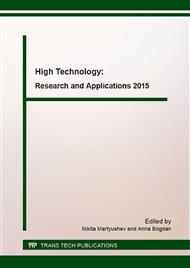[1]
H.A. Kramers, Brownian motion in a field of force and the diffusion model of chemical reactions, Physica 7 (1940) 284-304.
DOI: 10.1016/s0031-8914(40)90098-2
Google Scholar
[2]
W.F. Brown Jr, Thermal fluctuations of a single-domain particle, Phys. Rev. 130 (1963) 1677-1686.
DOI: 10.1103/physrev.130.1677
Google Scholar
[3]
V.M. Strutinsky, The fission width of excited nuclei, Phys. Lett. B, 47 (1973) 121-123.
Google Scholar
[4]
J. Burki, C.A. Stafford, D.L. Stein, Theory of metastability in simple metal nanowires, Phys. Rev. Lett., 95 (2005) 090601.
Google Scholar
[5]
H. Hofmann, F.A. Ivanyuk, Mean first passage time for nuclear fission and the emission of light particles, Phys. Rev. Lett. 90 (2003) 132701.
DOI: 10.1103/physrevlett.90.132701
Google Scholar
[6]
С. Schmitt, P.N. Nadtochy, A. Heinz, B. Jurado, A. Kelic, K. -H. Schmidt, First experiment on fission transient in fissile spherical nuclei produced by fragmentation of radioactive beams, Phys. Rev. Lett. 99(2007) 042701.
DOI: 10.1103/physrevlett.99.042701
Google Scholar
[7]
N.E. Aktaev, I.I. Gontchar, A modified Kramers approach to describing the fission of excited atomic nuclei, Bulletin of the Russian Academy of Sciences: Physics, 75 (2011) 994-997.
DOI: 10.3103/s1062873811070045
Google Scholar
[8]
D.J. Bicout, A.M. Berezhkovskii, A. Szabo, G.H. Weiss, Kramers-Like Turnover in Activationless Rate Processes, 83 (1999) 1279-1282.
DOI: 10.1103/physrevlett.83.1279
Google Scholar
[9]
E. Pollak, Variational transition state theory for activated rate processes, Jour. Chem. Phys., 93 (1990) 1116-1124.
DOI: 10.1063/1.459175
Google Scholar
[10]
E.G. Pavlova, N.E. Aktaev, I.I. Gontchar, Modified Kramers formulas for the decay rate in agreement with dynamical modeling, Physica A 391 (2012) 6084-6100.
DOI: 10.1016/j.physa.2012.06.064
Google Scholar
[11]
I.I. Gontchar, R.A. Kuzyakin, E.G. Pavlova, N.E. Aktaev, The nuclear fission process as Brownian motion: modifying the Kramers fission rates, Journal of Physics: Conference Series 381 (2012) 012089.
DOI: 10.1088/1742-6596/381/1/012089
Google Scholar
[12]
I.I. Gontchar, M.V. Chushnyakova, N.E. Aktaev et. al., Disentangling effects of potential shape in the fission rate of heated nuclei, Phys. Rev. C, 82 (2010) 064606.
DOI: 10.1103/physrevc.82.064606
Google Scholar
[13]
P. Hanggi, P. Talkner, M. Borkovec, Reaction-rate theory: fifty years after Kramers, Reviews of Modern Physics 62 (1990) 251-341.
DOI: 10.1103/revmodphys.62.251
Google Scholar
[14]
E.G. Pavlova, N.E. Aktaev, I.I. Gontchar, Corrections to Kramers formula for the fission rate of excited nuclei, Bulletin of the Russian Academy of Sciences: Physics, 76 (2012) 1098-1102.
DOI: 10.3103/s1062873812080217
Google Scholar
[15]
I.I. Gontchar, E.G. Pavlova, A.L. Litnevsky, N.E. Aktaev, How much accurate is description of nuclear fission rate by means of Kramer's formula?, 3rd International Conference on Current Problems in Nuclear Physics and Atomic Energy, NPAE 2010 - Proceedings, (2011).
DOI: 10.1088/1742-6596/312/8/082023
Google Scholar
[16]
O. Edholm, O. Leimar, The accuracy of Kramers' theory of chemical kinetics, Physica A. 98 (1979) 313-324.
DOI: 10.1016/0378-4371(79)90182-1
Google Scholar
[17]
P. Fröbrich and G. –R. Tillack, Path-integral derivation for the rate of stationary diffusion over a multidimensional barrier, Nuclear Physics A. 540 (1991) 353 – 364.
DOI: 10.1016/0375-9474(92)90209-3
Google Scholar
[18]
P. Fröbrich and A. Ecker, Langevin description of fission of hot metallic clusters, Euro Physics Journal D. 3 (1998) 245 – 256.
DOI: 10.1007/s100530050171
Google Scholar
[19]
J. -D. Bao and Y. Jia, Determination of fission rate by mean last passage time, Physical Review C. 69 (2004) 027602.
DOI: 10.1103/physrevc.69.027602
Google Scholar
[20]
J. -D. Bao and Y. Jia, Last passage time statistics for barrier-crossing processes, Journal of Statistical Physics. 123№ 4 (2006) 861 – 869.
DOI: 10.1007/s10955-006-9082-2
Google Scholar
[21]
B. Yilmaz, S. Ayik, Y. Abe and D. Boilley, Non-Markovian diffusion over a parabolic potential barrier: influence of the friction-memory function, Physical Review E. 77 (2008) 011121.
DOI: 10.1103/physreve.77.011121
Google Scholar
[22]
P. Fröbrich and G. –R. Tillack, Path-integral derivation for the rate of stationary diffusion over a multidimensional barrier, Nuclear Physics A. 540 (1991) 353 – 364.
DOI: 10.1016/0375-9474(92)90209-3
Google Scholar
[23]
D. Boilley and Y. Lallouet, Non-markovian diffusion over a saddle with a generalized Langevin equation, Journal of Statistical Physics. 125 № 2 (2006) 477 – 493.
DOI: 10.1007/s10955-006-9197-5
Google Scholar
[24]
P.N. Nadtochy, A. Kelic and K. -H. Schmidt, Fission rate in multi-dimensional Langevin calculation, Physical Review C. 75 (2007) 064614.
Google Scholar


